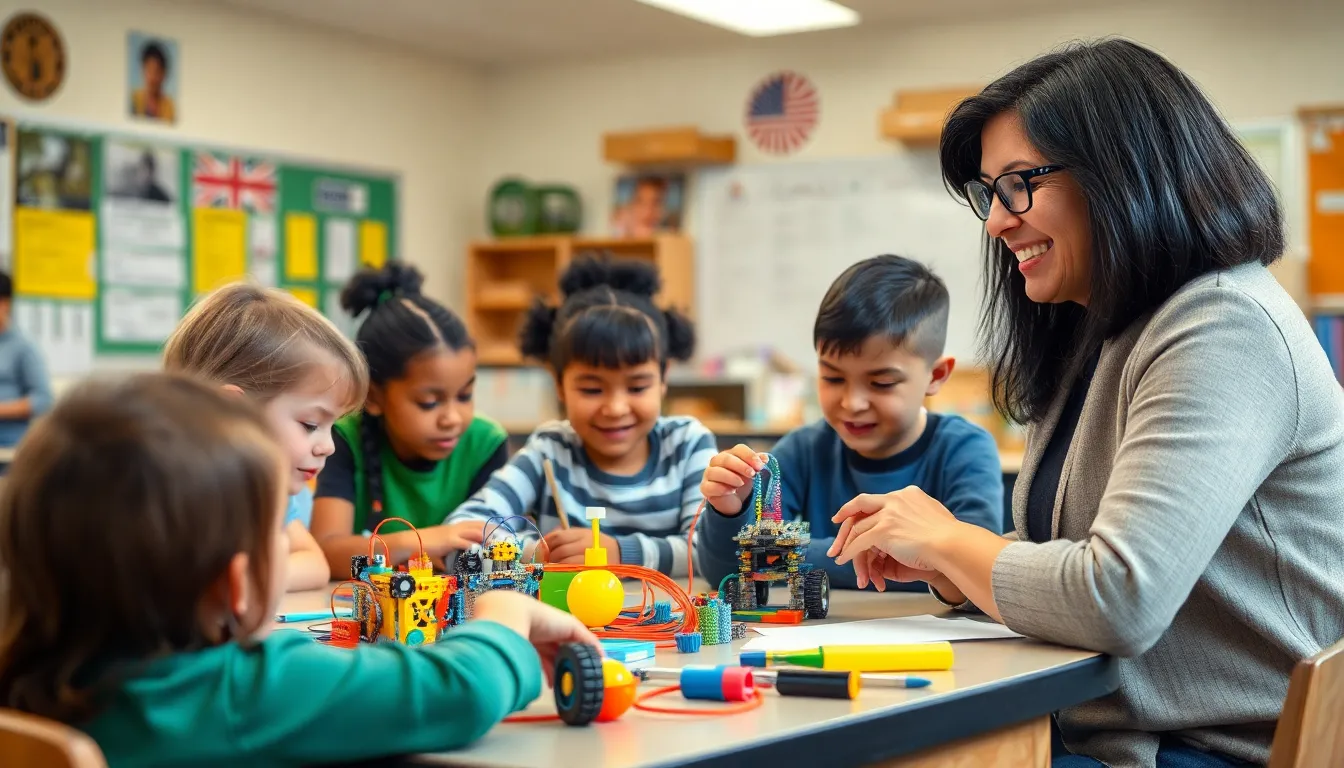In a world where kids are glued to screens, STEM toys are the superheroes that swoop in to save the day. These magical little gadgets don’t just entertain; they spark curiosity and ignite a passion for science, technology, engineering, and math. But wait—there’s more! When aligned with educational curricula, these toys become the ultimate sidekicks for teachers and parents alike, transforming learning into an adventure.
Table of Contents
ToggleImportance of STEM Toys in Education
STEM toys play a critical role in education by cultivating skills such as problem-solving, critical thinking, and collaboration. Engaging with these toys allows children to explore complex concepts in science, technology, engineering, and math. Development of fine motor skills occurs as children build, manipulate, and experiment with various materials.
Education systems benefit when STEM toys align with curricular goals. They not only support academic content but also encourage hands-on learning experiences. Such integration fosters deeper understanding and reinforces theoretical knowledge with practical application.
Research indicates that children exposed to STEM-related activities show increased interest in these fields. Interaction with STEM toys sparks creativity and innovation, which are essential for future careers in technology and science. Engagement in these playful learning environments enhances cognitive development, making education both enjoyable and effective.
Teachers can leverage STEM toys to create interactive learning experiences. Implementing these resources invites students to participate actively in their education. Aligning curriculum standards with the use of STEM toys bridges knowledge gaps and strengthens foundational skills.
Parents also play a vital role in supporting the use of STEM toys at home. When families engage with these toys together, they create a foundation for lifelong learning. Promoting discussions about scientific concepts leads to greater interest and understanding of complex subjects.
Together, education stakeholders can harness the power of STEM toys to build curiosity and equip the next generation with essential skills for success in an increasingly technology-driven world.
Overview of STEM Toys Curriculum Alignment

Understanding STEM toys’ alignment with educational curricula proves essential for enhancing the learning experience. Curriculum alignment involves ensuring educational materials and activities connect to specific educational standards and goals.
Definition of Curriculum Alignment
Curriculum alignment refers to the systematic connection between learning objectives, instructional strategies, and assessment methods. This process ensures educational tools like STEM toys match the desired learning outcomes. By aligning toys with curricula, educators create coherent learning experiences that facilitate student engagement. Teachers utilize these toys to reinforce theoretical concepts, making lessons more interactive and meaningful. Students benefit from hands-on exploration that complements classroom instruction.
Benefits of Curriculum Alignment in STEM Education
Curriculum alignment in STEM education offers numerous advantages. Strong alignment enhances student understanding by integrating multiple learning approaches such as hands-on activities and theoretical lessons. Engaging with STEM toys fosters critical thinking and problem-solving skills among learners. Research indicates that aligned curricula lead to improved academic performance and increased interest in STEM subjects. By using aligned STEM toys, educators cultivate a passion for science and technology, preparing students for future careers. Moreover, curriculum alignment supports collaborative learning experiences, encouraging teamwork and communication skills essential for success.
Types of STEM Toys
STEM toys come in various forms, each designed to enhance different aspects of learning. These toys encourage exploration while aligning closely with educational objectives.
Robotics and Coding Toys
Robotics and coding toys engage children in programming and mechanical design, indispensable skills for the future. Many products allow users to build robots that can perform tasks, fostering creativity and logical thinking. For example, kits like LEGO Mindstorms and Dash Robot introduce concepts of coding in an interactive manner. Children learn through trial and error, a critical aspect of problem-solving. These experiences promote teamwork when used in group settings, allowing for shared learning opportunities.
Science Experiment Kits
Science experiment kits stimulate curiosity through hands-on activities and real-world applications. These kits, such as National Geographic Science Magic and Snap Circuits, cover various scientific disciplines. Through conducting experiments, children grasp fundamental concepts like chemical reactions and physics principles. Bite-sized activities encourage independent exploration while allowing for guided parental involvement. Each kit aligns with scientific standards, ensuring learners gain applicable knowledge relevant to their education.
Engineering Building Sets
Engineering building sets cultivate spatial awareness and critical thinking through construction challenges. Toys like K’NEX or Magformers invite children to design structures, reinforcing concepts in physics and engineering design. Creating models allows users to test their ideas, making them aware of design flaws and solutions. Collaborative building projects enhance communication skills and teamwork while embedding educational standards into play. These sets support deeper understanding by connecting theory with practical experience.
Evaluating STEM Toys for Curriculum Alignment
Evaluating STEM toys for their alignment with educational curricula involves specific criteria and best practices. This assessment ensures that toys effectively support learning objectives.
Assessment Criteria
Criteria include alignment with standards, age appropriateness, and engagement potential. Alignment with educational standards ensures that toys meet specific learning goals. Age appropriateness guarantees that challenges match children’s capabilities. Engagement potential focuses on how well the toy promotes interaction and curiosity. Consider whether the toy fosters critical thinking and problem-solving skills. Finally, evaluate if it encourages collaboration, which is essential for teamwork in learning environments.
Best Practices
Adopting best practices promotes effective integration of STEM toys into curricula. First, educators should identify clear learning objectives before selecting toys. Connecting toys directly to lesson plans maximizes relevance. Structuring activities that utilize these toys enhances hands-on learning experiences. Additionally, encouraging collaboration among students through group activities fosters communication skills. Regularly assessing the effectiveness of toys in achieving desired outcomes is crucial. Leveraging feedback from both teachers and students ensures ongoing improvement.
Case Studies of Successful Implementation
Numerous schools have showcased effective integration of STEM toys into their curricula. One notable example is a middle school in California, where educators used robotics kits to teach engineering concepts. Students engaged in hands-on projects that encouraged teamwork and fostered problem-solving abilities. The curriculum emphasized collaboration, linking STEM toy use directly with learning objectives.
Another case involves an elementary school in Texas that implemented science experiment kits in its science classes. Students conducted experiments aligned with national standards, sparking interest in scientific exploration. The structure of the lessons allowed for creativity and inquiry, making science accessible and engaging.
In New York, a high school focused on coding toys to enhance computer science education. Students designed their programs and built prototypes, strengthening their programming skills while connecting theory with real-world applications. Assessments reflected significant improvements in students’ understanding of coding concepts.
A community center in Florida also leveraged STEM toys for after-school programs targeting underprivileged children. Robotics and engineering activities attracted participants, fostering enthusiasm for STEM fields. Data showed increased interest, with many students pursuing further education in technology-related subjects.
Lastly, a nonprofit organization implemented a STEM toy initiative in rural areas, distributing science kits to local schools. Educators received training on curriculum alignment, ensuring effective integration into existing programs. Feedback indicated improved student engagement and academic performance within these communities.
These examples illustrate the diverse ways STEM toys can align with educational curricula. Integration of hands-on learning experiences consistently leads to enhanced student engagement, creativity, and academic achievement.
STEM toys are more than just playthings; they’re vital tools that bridge the gap between theoretical knowledge and practical application. By aligning these toys with educational curricula, educators can create engaging learning experiences that not only captivate students but also enhance their understanding of complex concepts.
The integration of STEM toys fosters critical skills such as problem-solving and collaboration while sparking interest in science and technology fields. As schools and parents work together to implement these resources, they pave the way for a generation equipped with the skills necessary for success in a technology-driven world. Embracing STEM toys in education is a step toward nurturing curiosity and innovation in young minds.








